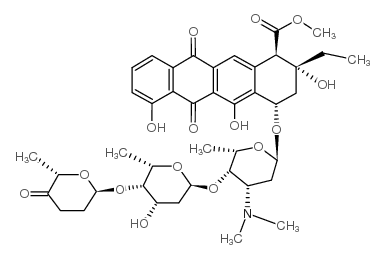57576-44-0
| Name | aclacinomycin A |
|---|---|
| Synonyms |
aclacur
ACLARUBLCIN Aclacin Jaclacin ACM Aclarubicin Aelacinon EINECS 260-824-3 MFCD00866250 ma144-a1 Aclaplastin |
| Description | Aclacinomycin A (Aclarubicin) is an orally active and potent anthracycline antitumor antibiotic. Aclacinomycin A is an inhibitor of topoisomerase I and II. Aclacinomycin A inhibits synthesis of nucleic acid, especially RNA. Aclacinomycin A might inhibit the 26S protease complex as well as the ubiquitin-ATP-dependent proteolysis[1][2][3]. |
|---|---|
| Related Catalog | |
| Target |
Topoisomerase I Topoisomerase II |
| In Vitro | Aclacinomycin A (0-120 μM, 30 min) inhibits the ubiquitin-ATP-dependent proteolytic activity of rabbit reticulocytes in a dose-dependent manner, with an IC50 of 52 μM. But it does not inhibit the ubiquitination[1]. Aclacinomycin A inhibits ubiquitin-ATP-dependent proteolysis after the conjugation of ubiquitin to proteins[1]. Aclacinomycin A (0-2.4 μM, 3 h) inhibits the topo II catalytic activity[2]. Aclacinomycin A (0-1.8 μM, 3 h) has negative effect on the proliferative rate of V79 and irs-2 cells[2]. Aclacinomycin A emits fluorescence and that human-cervical cancer HeLa cells exposed to Aclacinomycin A exhibits bright fluorescence signals in the cytoplasm when fluorescence microscopy was performed using the red filter (excitation 530-550 nm/emission 575 nm)[3]. Cell Viability Assay[2] Cell Line: V79 and irs-2 cells Concentration: 0, 0.006, 0.12, 1.2, and 2.4 μM Incubation Time: 3 h Result: Inhibited the topo II catalytic activity in a dose-dependent manner. The loss of topo II catalytic activity in ACLA-treated cells was in all cases significant compared with non-treated cells. Cell Proliferation Assay[2] Cell Line: V79 and irs-2 cells Concentration: 0, 0.12, 0.25, 0.37, 0.6, 1.2, 1.8 μM Incubation Time: 3 h Result: Showed a dose-dependent negative effect on the proliferative rate of V79 and irs-2 cells, but the reduction in surviving colonies was higher in the radiosensitive irs-2 cells for most of the ACLA doses tested. |
| In Vivo | Aclacinomycin A (0.75-6 mg/kg, IP, daily) dose-dependently exhibits tumor growth in mice-based Leukemia P-388 model[4]. Aclacinomycin A (0.6-20 mg/kg, Orally, daily) exhibits an antitumor effect on leukemia L-1210[4]. Aclacinomycin A is very well absorbed in mice, rats, and dogs after its oral administration. The oral LD50 (76.5 mg/kg) is about twice the iv LD50 (35.6 mg/kg) in mice[4]. Animal Model: DBA/2, CDF1 (BALB/c×DBA/2) mice with Leukemia P-388 (90-110 g)[4]. Dosage: 0.75 mg/kg, 1.5 mg/kg, 3 mg/kg, 6 mg/kg Administration: Intraperitoneal administration daily for 10 days starting 3 hr after transplantation. Result: Inhibited tumor growth. Animal Model: CDF1 mouse with Leukemia L-1210[4] Dosage: 0.6 mg/kg, 1.25 mg/kg, 2.5 mg/kg, 5 mg/kg, 10 mg/kg, 20 mg/kg Administration: Orally, daily for days 1-9 Result: Exhibited an antitumor effect on leukemia L-1210. |
| Density | 1.42 g/cm3 |
|---|---|
| Boiling Point | 897.7ºC at 760 mmHg |
| Melting Point | 151-153ºC |
| Molecular Formula | C42H53NO15 |
| Molecular Weight | 811.86800 |
| Flash Point | 496.7ºC |
| Exact Mass | 811.34200 |
| PSA | 217.05000 |
| LogP | 3.15770 |
| Index of Refraction | 1.629 |
| Hazard Codes | T |
|---|---|
| Risk Phrases | R25 |
| Safety Phrases | S36/37/39-S45 |
| RIDADR | 3249 |
| RTECS | QI9279300 |
| Packaging Group | II |
| Hazard Class | 6.1(a) |
